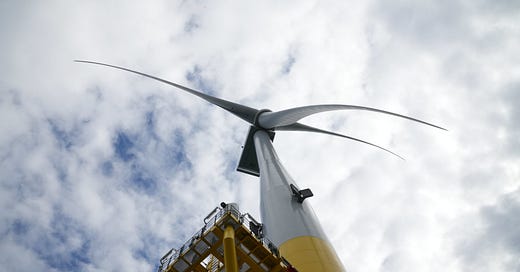Happy weekend!
Where I live in the US Pacific Northwest, spring is quickly turning into summer. The city that’s gray for most of the year gets a sunbath. The days are longer, people spend their afternoons and weekends outside, moods improve. This is what nine months of rain was all for!
So generally speaking, I’m in good spirits these days. Wherever you are, I hope you’re also happy and content.
Seasons change, but the need for the energy transition doesn’t. The struggle to keep temperatures within 1.5°C of pre-industrial levels continues (although unachievable in all likelihood) and the COP28 goal of tripling global renewable energy capacity by 2030 still stands.
I’ve been paying a lot of attention to offshore wind as one of the renewable energy technologies with the biggest potential to help hit that goal. So last week, I wrote about the saga of three offshore wind projects slated to be built in Japan by 2030. Long story short, Mitsubishi Corp. stunned the industry by winning the right to build all of the offshore wind farms on offer in Japan’s first public auction in 2021. But then, just recently, Mitsubishi announced that it may not be able to build them because of rising costs. In the post, I argue that a combination of poor policy design and worsening macroeconomics are at the root of this bad news.
If they actually get built, Mitsubishi’s three wind farms will be off the coasts of Akita prefecture in northern Japan and Chiba prefecture in eastern Japan. They will be fixed bottom — i.e. built into the ocean floor, steadfast to wave and wind.
When we talk about the state of wind energy today, the vast majority of wind turbines in operation worldwide are onshore (92% in terms of generation capacity), and the vast majority of offshore wind is fixed bottom.1
But intergovernmental organizations call for at least 2,000 GW of offshore wind deployed by 2050 (over 24-fold increase from today!) to deliver net zero emissions by the middle of the century. If we are to trust the expertise of these organizations (which I tend to), then floating offshore wind is a critical technology to get right and scale up despite its nascency today.
This week, I want to share with you my stock-take of Japan's floating offshore wind industry that appeared on Energy Tracker Asia.
At the end of 2023, Japan had a cumulative installed offshore wind capacity of 153.5 MW. 148.5 MW of that was fixed-bottom. While the Global Wind Energy Council says that this positions Japan as a key offshore wind player in the Asia-Pacific, only 5 MW — or 2 turbines — of that capacity is of the floating sort.
Fortunately, the Japanese government and industry leaders know that floating offshore wind holds huge promise for Japan to become a leader in renewable energy.
To create this technically difficult and costly industry essentially from scratch, the government is taking several steps:
In January 2024, it reformed a law to expand offshore wind development beyond territorial waters and into Japan’s enormous Exclusive Economic Zone.
This year, policymakers are updating the “Vision for Offshore Wind Power Industry,” which will explicitly set floating-specific targets for the first time.
Government agencies like the New Energy and Industrial Technology Development Organization (NEDO) are providing subsidies for technological and supply chain development.
Private companies are also on board, launching several initiatives to establish supply chains and technical know-how:
In March 2024, major utilities helped launch the Floating Offshore Wind Technology Research Association (FLOWRA), a consortium focused on large-scale floating wind commercialization.
Construction, steel engineering, shipbuilding, and lifting machinery companies founded the Floating Offshore Wind Construction System Technology Research Association (FLOWCON) to build cost-effective floating structures at scale.
June 2024 saw the launch of a public-private initiative called Education Council for Offshore Wind (ECOWIND), whose mission is to develop the highly skilled workforce needed for manufacturing, building and maintaining floating offshore wind turbines.
But challenges similar to the ones befalling Mitsubishi’s fixed-bottom offshore wind projects bedevil Japan’s floating offshore wind industry: rising material costs, a cumbersome permitting process, and limited port and grid infrastructure. It’s up to policymakers, corporate decision-makers, and academic experts to find ways to overcome these hurdles.
The article is free to read. Give it a read!
Thank you for reading Power Japan. If you’re not already a subscriber, consider becoming one to get all of my posts in your inbox. A paid subscription of USD 10.00 per month will get you access to the Deep-Dive and Conversation posts.
Comments, questions, or suggestions? Let me know in the comments or the subscriber chat.
My simple calculation based the Global Wind Energy Council’s Global Wind Report 2025: There’s currently 1,052.3 GW of global cumulative wind capacity, 83.2 GW of which are offshore (p. 82). Of this, operational floating offshore wind capacity totaled 245 MW (1 MW is one-thousandth of a GW).






